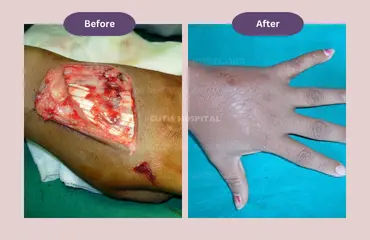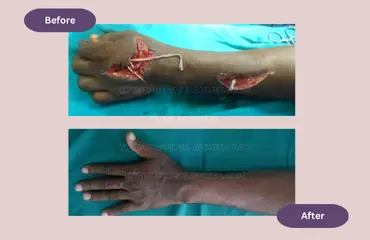A tendon is a firm cord attached to the bone at both ends of a muscle, which enables the movement of your joints. Numerous muscles are present in your body, but some of them might stop functioning properly because of an injury or unwanted force.
To fix that situation and make these muscles and tendons work appropriately, Tendon Transfer Surgery is done to replace these malfunctioning or disabled muscles/tendons.
During the surgery, when a tendon gets damaged, the doctor performs surgery and replaces the damaged tendon with a functional one so that the routine tasks do not get affected by the damaged tendon.
In simple words, a type of hand surgery performed to replace the non-working/damaged tendon present in the hand with an appropriately functioning tendon so that the quality of the work stays intact and routine activities do not get affected by the damaged tendon.
They will add a perfectly working tendon to a new place in place of the damaged tendon existing to restore the potential of the hand.
Tendon Transfer Surgery becomes mandatory when a particular muscle loses its potential and functioning because of an injury. When a muscle gets damaged because of an injury, it is longer able to receive the signals sent by the nerve due to which the muscle gets paralyzed and the functioning of that muscle is lost.
The spinal cord, Radial nerve, Ulnar nerve, or Median nerve injury are a few instances of injuries that are usually treated with Tendon Transfer Surgery.
The surgeons will perform the surgery while you're asleep or while you're awake with mild sedation of the body part where the surgery will be done. The dosage of Anesthesia varies as per the severity of the injury.
During the procedure, the doctor will cut or two to replace the damaged tendon with the functional one. The damaged tendon is removed and the tendon of extra muscle or an extra tendon of a significant muscle is placed and sewn where the damaged tendon existed. After replacing the damaged tendon, the surgeon closes the incision with stitches.
After the completion of your surgery, you will be provided with a cast or a splint to protect the tendon transfer and the stitches until the replaced tendon settles with the new muscle and the incision is closed.
Furthermore, hand therapy is advisable to put the hand back in its regular motion. Although, it is mandatory to follow the instructions given by the physiotherapist because excess or lack of exercise can have undesirable outcomes.
In addition to Tendon Transfer Surgery, there are other options available to fix the situation:
Every surgery has some risk, some risks are significant while some are not. Despite early risks or complications being uncommon during this procedure, given below is a list of early risks:
Moreover, later risks are enlisted below:
You can better understand the dangers and advantages of tendon transfer surgery by discussing your particular case with your hand surgeon.
Several principles have been established to enhance the potential and success rate of tendon transfer surgeries over the last century. Even though sticking with these principles might not result in complete success, ignoring them will have failed outcomes.
We have enlisted a few principles of tendon transfer below:
In most cases, all kinds of surgeries require at least 1-2 months to recover completely. And it is important to take appropriate care during this period. The surgeon will also provide a split to protect the replaced tendon and provide efficient time to close the incision during this time.
As soon as the incision is closed and the replaced tendon settles down, the cast is removed and your surgeon might advise you to perform several hand exercises or go for physiotherapy to restore the normal movement and potential of your hand.
During this period, it is necessary to take care of your activities as excess and lack of movement might result in rupture of the transfer or stiffness & scarring of the tendon.
Cutis Hospital is the leading hospital with skilled surgeons, equipment, standard procedure, and best-in-class patient care for desired results and patient care.
Skilled surgeons
It is mandatory to ensure the severity of the injury to take a proper decision for treatment. As different types of treatment can be opted for in case of a tendon injury, it is necessary to opt for the most suitable one to ensure the safety of the patient. Doctors at Cutis possess complete theoretical knowledge and years of practical experience regarding tendon injuries and Tendon Transfer Surgeries.
End-to-End patient care
These experts try to keep the incision as small as possible and try to complete the surgery in as less time as possible. It helps the patient by reducing pain while also minimizing the consumption of antibiotics. Besides that, specialists at Cutis also take proper care of stitches and cover them completely, which protects the stitches from getting infected and makes the condition worse.
Proper post-operative care
Moreover, as these surgeries require more than a month or two to recover completely these doctors also provide appropriate aftercare once the surgery is over. These doctors will prescribe proper medication to protect the incision from getting infected. The equipment used to perform surgeries is also maintained and cleaned thoroughly by the staff, which helps in preventing diseases caused by unclean surroundings and makes the situation worse.
If you have the symptoms and are looking for an accurate diagnosis & best treatment, then reach out to us right away!




It is necessary to undergo tendon transfer surgery to replace the damaged tendon. Otherwise, the infection will spread, resulting in problems later on.
It takes roughly 1-2 months for tendon transfer surgery to recover completely.
Yes, if appropriate aftercare is not done and the stitches are not covered properly, then there’s a high chance of the wound getting infected.
No, the surgery can also be performed by sedating only the body that is supposed to undergo the surgery.
Yes, the surgery and incision might be excruciatingly painful, but painkillers given in the form of injections and tablets will suppress the pain to some extent.
Yes, hand therapy and exercises are necessary to recover your hands’ lost movement and potential.
Cutis Hospital is conveniently located in Ghatlodia, Ahmedabad, making it easily accessible via multiple modes of transportation. Below are the various ways you can reach our facility:
Sardar Vallabhbhai Patel International Airport: Located approximately 12.7 km from Cutis Hospital, offering convenient access for patients traveling from outside the city.
Chandlodiya Railway Station: Approximately 2.4 km from Cutis Hospital.
Ahmedabad Railway Station: Around 11 km from our center.
GSRTC:
Ahmedabad Central Bus Station (GSRTC): About 10.3 km from the hospital.
AMTS:
Bhuyangdev Cross Road Bus Stop: Just 500 meters from Cutis Hospital.
BRTS:
Bhuyangdev BRTS Bus Stop: Only 170 meters from our center.
We provide effective surgical and non-surgical treatments for all parts of the body. At Cutis Hospital, our cosmetic and plastic surgery team is committed to giving patients safe and high-quality care.